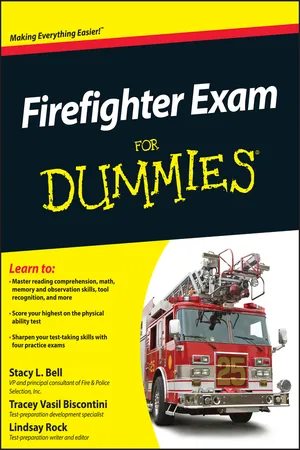Part I
So You Want to Be a Firefighter? Get Ready!
In this part . . .
Has it been your lifelong dream to jump into a shiny, red fire engine with screaming sirens and flashing lights and race to someone’s rescue? Do you want to make your dream a reality? First things first. Before you can leap into that fire engine, check out the process for becoming a firefighter.
We know you’re eager to get started, but take a few minutes to read Part I. This part provides information about careers in the fire service, the firefighter hiring process, and the various pre-employment firefighter exams. The more you know about the hiring process and the exams, the more prepared you’ll be for each stage down the road.
Chapter 1
Getting the Lowdown on the Job of Firefighter
In This Chapter
Understanding firefighters’ duties and work environment Realizing the risks associated with firefighting Identifying the levels of fire departments’ occupational hierarchy Pinpointing where to find firefighting jobs Looking ahead at the occupational outlook for firefighters Why does a career in firefighting appeal to you? Do you enjoy the physical demands of the job? Do you cherish the opportunity to save a life? Do you like the feeling that your job gives something back to the community? Many career firefighters believe that they didn’t choose the job — the job chose them. Perhaps you’ve experienced a similar calling, or maybe you’re inspired by the good work you’ve seen other firefighters do. Regardless, before you become a firefighter, you need to understand exactly what the job entails.
In this chapter, we give you information about careers in firefighting, such as salaries, employment outlooks, work environments, ranks within fire organizations, and risks associated with the job. Although firefighter exams won’t likely test your knowledge of this information, it’s still important to know what you’re likely to encounter if you plan to make firefighting your career.
Understanding What It’s Like to Be a Firefighter
Firefighting has certainly changed from the early days of bucket brigades and horse-drawn fire trucks. Today’s firefighters must be prepared to not only fight fires but also respond to crises ranging from traffic accidents and medical emergencies to natural disasters, water rescues, and sadly, even terrorist attacks. Before entering a career in the fire service, it’s important that you understand what firefighters do and where they work, as well as the risks associated with the job.
Knowing your role
Movies and television would have you believe that you’ll spend most of your time tracking down serial arsonists or racing out of a burning building, an unconscious victim draped over each shoulder, just as the structure behind you explodes into a huge fireball. Although such scenarios do happen on occasion, you’ll more often respond to rush-hour fender benders and activated fire alarms caused by overcooked pot roast. The following sections cover some of the roles you may play, both at the station and away.
Responding to emergencies
As a firefighter, you’ll be responsible for a number of duties. Most obvious among those duties is fighting fires, but you’ll also respond to a variety of other emergencies, from minor nuisances such as a fallen tree blocking a roadway to major incidents such as gas leaks, traffic accidents, vehicle rollovers, plane crashes, building collapses, and floods.
When disasters occur, firefighters often are the first responders. As a result, many departments require firefighters to be trained as emergency medical technicians (EMTs) so they can provide first aid and perform other life-saving medical procedures on victims. Most departments require only the most basic EMT certification (EMT-Basic), but many are moving toward requiring more advanced training (EMT-Intermediate or EMT-Paramedic).
As a firefighter EMT, you’ll likely be the first person to encounter victims experiencing medical emergencies such as heart attacks, strokes, burns, broken bones, shock, blocked airways, bleeding, and more. Firefighting is not for the squeamish or the faint of heart. When you respond to an emergency, you never know what you might find when you arrive. Our best advice is to be prepared for anything and everything.
Other responsibilities include rescues, not only from burning buildings but also from hard-to-reach places, such as lakes or rivers or even steep cliffs. You may have to help clean up hazardous materials. For example, when a truck hauling oil overturns on a highway, fire departments are often called to block roadways, prevent fire, clean up the oil, assist injured victims, and more. During floods, you may have to notify people to evacuate their homes or help them pump water from their homes after flood waters begin to recede.
Firefighters often work in conjunction with other emergency services, including police departments, other fire departments (for example, a state- or county-run wildland firefighting team), and paramedics and ambulance personnel. When working with other emergency services, you’ll follow the direction of your superiors, who are responsible for coordinating with other units.
Working back at the station and in the community
Here are some of the tasks firefighters fulfill when they’re not on an emergency call:
Household chores: Firefighters in many departments, especially small or rural departments, have a lot of downtime between calls, which they spend at the station. There, you’ll take care of everyday tasks such as laundry (firefighting’s a dirty job), cooking (shifts are long; you’ll need food keep your motor running), and cleaning (treat the station like your home away from home). Training and preparation: As a new firefighter, training and preparation will make up most of your job. After you’ve gotten a few years of service under your belt, you’ll likely use downtime to review new skills, read fire science literature, study for upcoming tests, run practice drills, prepare written reports, work out, and assist new firefighters with their training. Equipment maintenance: You may be asked to assist in per... 


